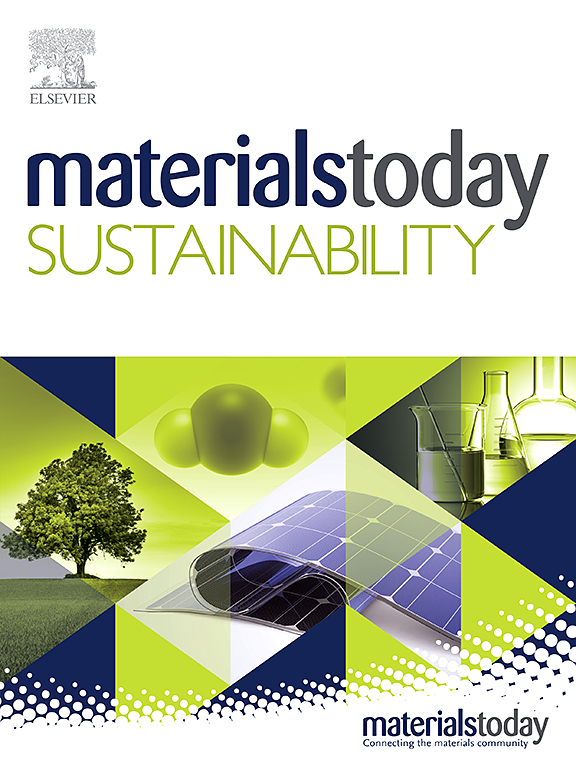Investigation of electrochemical features of a novel Ni2P2O7-Polyaniline nanohybrid as electroactive material in high-reliable supercapacitors
IF 7.1
3区 材料科学
Q1 GREEN & SUSTAINABLE SCIENCE & TECHNOLOGY
引用次数: 0
Abstract
A novel nanohybrid of Ni2P2O7-Polyanaline (NPP) has been engineered to study energy storage performance. The nanohybrid was fabricated by surface coating of Ni2P2O7 layered nanostructure (NPL) with the conductive polymer polyaniline (PANI). Initially, pristine Ni2P2O7 layered nanostructure (NPL) was synthesized through single-step hydrothermal approach. Subsequently, hybrid composite (NPP) was constructed using in-situ oxidative polymerization of aniline monomer. The structural, morphological, and compositional properties of synthesized samples were characterized via XRD, FTIR, SEM, TEM, XPS and BET analysis. The electrochemical performances of the materials were evaluated for supercapacitor performance using Cyclic Voltammetry (CV), Galvanostatic Charge-Discharge (GCD) test, Electrochemical Impedance analysis (EIS), and cyclic stability assessments. The results demonstrated that the hybrid composite exhibited significantly enhanced capacitance of 1333.9 F/g at 1 mV/s, 1150 F/g at 1 A/g from CV and GCD measurements respectively, including impressive stability performance, retaining 95% of its capacitance over 7000 CV cycles. Furthermore, symmetrical supercapacitor device constructed using NPP electrodes and operated at potential window of 1.6 V. The assembled symmetric device demonstrated superior energy density, power density, and cycling performance. The improvements in the performance of the three and two-electrode systems are attributed to PANI coating on the NPL surface, indicating that the hybrid composite is promising candidate for highly reliable supercapacitors.

新型ni2p2o7 -聚苯胺纳米杂化材料在高可靠性超级电容器中的电化学特性研究
设计了一种新型的ni2p2o7 -聚苯胺(NPP)纳米杂化材料来研究其储能性能。采用导电聚合物聚苯胺(PANI)在Ni2P2O7层状纳米结构(NPL)表面涂覆制备了纳米杂化材料。首先,通过一步水热法合成了原始Ni2P2O7层状纳米结构(NPL)。随后,采用原位氧化聚合法制备了苯胺单体杂化复合材料(NPP)。通过XRD、FTIR、SEM、TEM、XPS和BET分析表征了合成样品的结构、形态和组成特性。通过循环伏安法(CV)、恒流充放电(GCD)测试、电化学阻抗分析(EIS)和循环稳定性评估来评价材料的超级电容器性能。结果表明,该复合材料在1mv /s和1a /g条件下的电容值分别达到1333.9 F/g和1150 F/g,具有良好的稳定性,在7000 CV循环中保持95%的电容值。在此基础上,利用NPP电极构建了在1.6 V电位窗口下工作的对称超级电容器器件。组装的对称器件表现出优越的能量密度、功率密度和循环性能。三电极和双电极系统性能的改善归功于在NPL表面涂覆聚苯胺,这表明混合复合材料是高可靠性超级电容器的有希望的候选者。
本文章由计算机程序翻译,如有差异,请以英文原文为准。
求助全文
约1分钟内获得全文
求助全文
来源期刊

Materials Today Sustainability
Multiple-
CiteScore
5.80
自引率
6.40%
发文量
174
审稿时长
32 days
期刊介绍:
Materials Today Sustainability is a multi-disciplinary journal covering all aspects of sustainability through materials science.
With a rapidly increasing population with growing demands, materials science has emerged as a critical discipline toward protecting of the environment and ensuring the long term survival of future generations.
 求助内容:
求助内容: 应助结果提醒方式:
应助结果提醒方式:


